Find out what these Wireless and Internet terms mean
Navigating wireless internet services and information for schools can be difficult, especially with the plethora of commonly used technical terms out there. We’ve put together a little glossary of some of the wireless and internet for schools terms you may have come across and hope it will help you making positive and strategic ICT decisions for your school.

5G: The fifth-generation of mobile telephony which broadband access to mobile devices with speeds of up to 100 gigabits per second, 5G is set to be as much as 100 times faster than 4G.
Access Point: An access point is any item of access hardware (including signal boosters and repeaters) for example tablets and iPads at your school, through which a user may access the internet. Often abbreviated as AP
Authentication: A client may be required to authenticate to the wireless network before it can pass data between itself and other hosts. Authentication can be open, but can also require a certificate, username/password, or pre-shared key. Your school may use this to limit and monitor internet access and usage.
Bandwidth: Bandwidth is the amount of data that can be carried from one point to another in a given time period (usually a second).
Bridge: A network device that interconnects two dissimilar network types. An AP can act as a bridge between the wired and wireless networks, but can also serve as a wireless connection between two wired segments.
BSSID: Basic Service Set Identifier and is the MAC address of the AP. All the devices at your school will have a unique MAC address.
Closed Network: A closed network requires users to have authentication information before they can get onto the network, often used by schools to limit and monitor internet access and usage.
Device: Any object made or adapted to connect to your schools WiFi network, i.e iPads, tablets, laptops, desktops and even wireless printers!
Domain Name Service (DNS): The DNS translates the plain-English URLs into the numerical IP address for the server that your school website resides on.
EAP: The Extensible Authentication Protocol (EAP) can be used to provide authentication to the wireless network when employing WPA-Enterprise and WPA2-Enterprise
Ethernet: Ethernet is the most pervasive connection type for wired networking at your school. Available in speeds from 10mbps all the way up to 10,000mbps (10gbit).
Firewall: A firewall is an added layer of Internet security provided by the router in your schools wireless network structure.
Gigabit: Is a measure of internet data transfer rate. I.e, 1 Gbps = 1,000 Mbps
Hotspot: An AP set up specifically to provide Internet access to users. Hotspots are popular in schools, and provide the convenience of free Internet access to students and staff.
IP Address: An IP address is a unique string of numbers separated by full stops that identifies each computer or device using the Internet Protocol to communicate over a school wireless network.
Local Area Network (LAN): A local area network is a small network that’s confined to a local area, e.g. home, school or office network.
MAC Address : A media access control address is a unique identifier assigned to network interface controllers for communications at the data link layer of a network segment. MAC addresses are used as a network address for most IEEE 802 network technologies, including Ethernet and WiFi.
Mbps: Megabits per second. Mbit/s or Mb/s, often abbreviated “Mbps” and is a unit of data transfer rate.
MIMO: Multiple Input/Multiple Output signaling that uses several transceivers and antennae to improve throughput and range of the wireless network. These could be utilised by schools to provide site-wide wireless coverage and access.
NFC: Near Field Communication is a technology used most often with mobile devices to exchange data based on proximity, or even physical contact. NFC technology is used in mobile phones for data transfer, touch to pay technologies, and smartcard reading. NFC is also being incorporated into some APs to make setting up a client easier. School meal payment cards and key-fobs may use this technology.
Ping: Ping is the signal sent from a user device to other nearby devices. For example, a mobile phone to an access point. The response time of the connection between these devices is used to determine the seen time for presence data.
Range: The distance between an AP and a users device (or between two APs) over which your schools WiFi transmissions can be successful.
Repeater: A wireless network device that receives signals and retransmits them, without providing direct access to the wired network. Repeaters are typically used to increase the range wireless networks can cover in schools.
Router: A router is a network device that forwards data packets from one network to another
SSID: Service Set Identifier is the defined name of the WiFi network that is broadcast from a WiFi enabled router or access point.
VLAN: A Virtual LAN (Local Area Network) is a logical sub-network that can group together a collection of devices from different physical LANs.
WiFi: WiFi simply means wireless network. WiFi is a facility allowing computers, smartphones, or other devices to connect to the schools Internet or communicate with one another wirelessly within a particular area.
